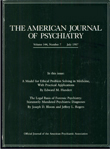This book represents the proceedings of a symposium, sponsored by Ciba-Geigy Pharmaceuticals, held in Prien, Germany, in September 1993. Each chapter is a presentation by a particular speaker, followed by a discussion in which other participants comment on the presentation.
Like most symposiums, this collection does not aspire to represent a comprehensive review of the field in the manner of a textbook, giving equal weight to all of the various topics within that field. For example, the book contains virtually nothing on the subjects of cocaine, cannabis, or stimulant abuse or dependence. Similarly, the book provides only spotty coverage of many aspects of the epidemiology, phenomenology, and treatment of substance dependence syndromes. On the other hand, the neurobiological aspects of opiate tolerance and dependence are reviewed in great detail in two chapters, which together make up almost 25% of the book. Overall, therefore, this is not a general text for the clinician interested in a comprehensive presentation on substance dependence, nor even a general reference for substance abuse specialists. Certain substance abuse researchers, on the other hand, may find some of the individual chapters of particular interest.
Among these chapters, I particularly recommend the two chapters on the neurobiology of opioid dependence, already mentioned, plus the chapter immediately following, in which Kalant offers a provocative hypothesis that drugs as diverse as ethanol, opioids, cocaine, cannabinoids, and benzodiazepines may share common mechanisms of reinforcement and tolerance. It is of interest that 4 years after the material in this chapter was presented, two new studies of cannabinoids (
1,
2) have appeared that seem to support Kalant's predictions about common mechanisms of reinforcement. Other interesting chapters discuss the important questions of how to define “relapse” in outcome analyses and the interactive effects of psychosocial and pharmacological treatments for substance abuse. In highlighting these chapters, I do not mean to demean the others; it is simply that they tend to discuss relatively circumscribed topics, such as individual studies or particular public health problems in specific European countries. Among these, for example, are a discussion of intravenous temazepam abuse and intranasal snorting of flunitrazepam in the United Kingdom, results of a methadone substitution trial in Germany, and observations on opiate addiction in pregnancy and the newborn from an Italian clinic. Although these are perfectly reasonable presentations, they may be of little interest to the average American reader.
In short, therefore, although I have no particularly serious criticisms of the presentations grouped in this volume, I fear that its potential audience is limited. Typical readers of the Journal, I think, will be unlikely to want to purchase it for their shelves.

